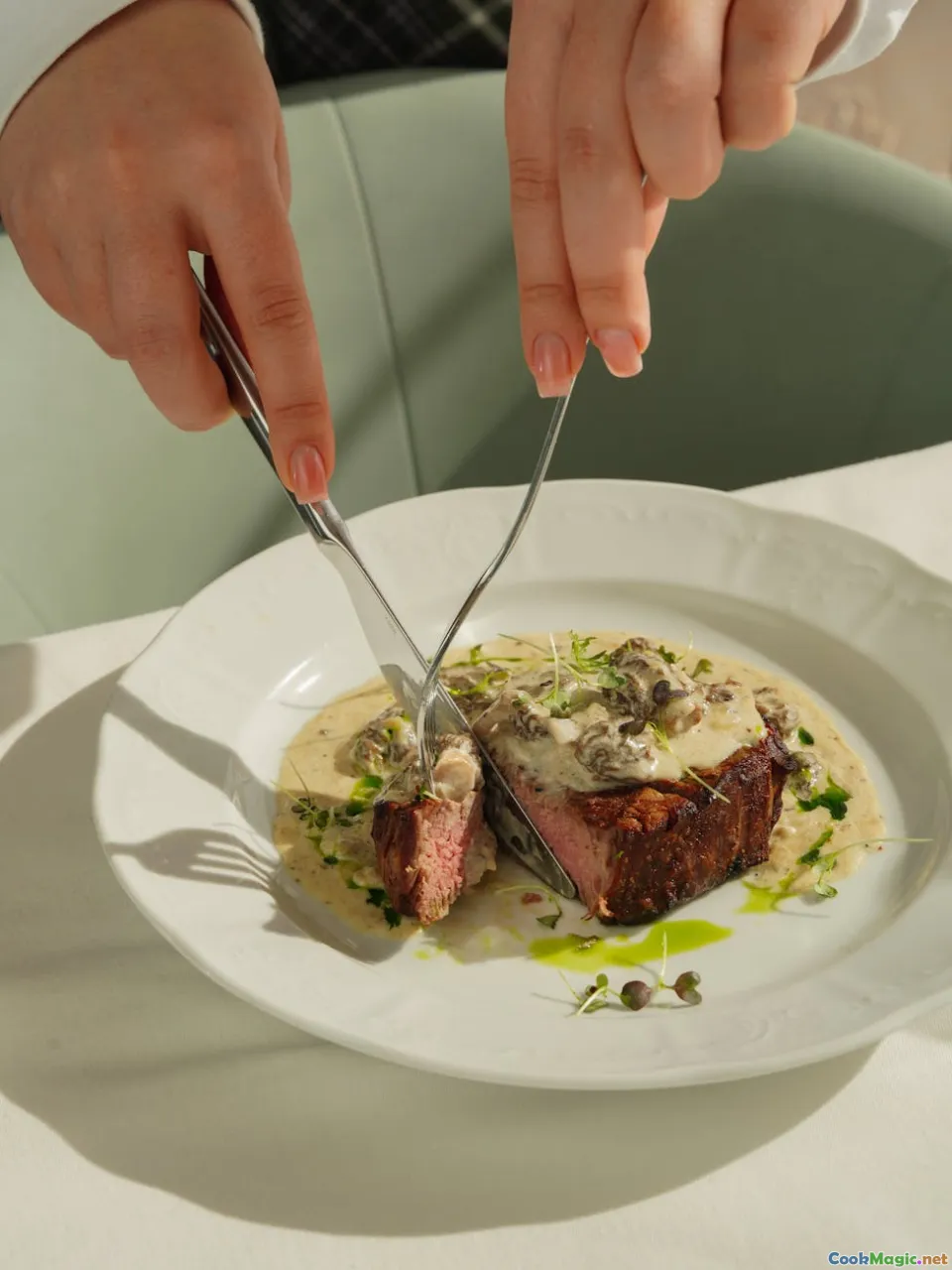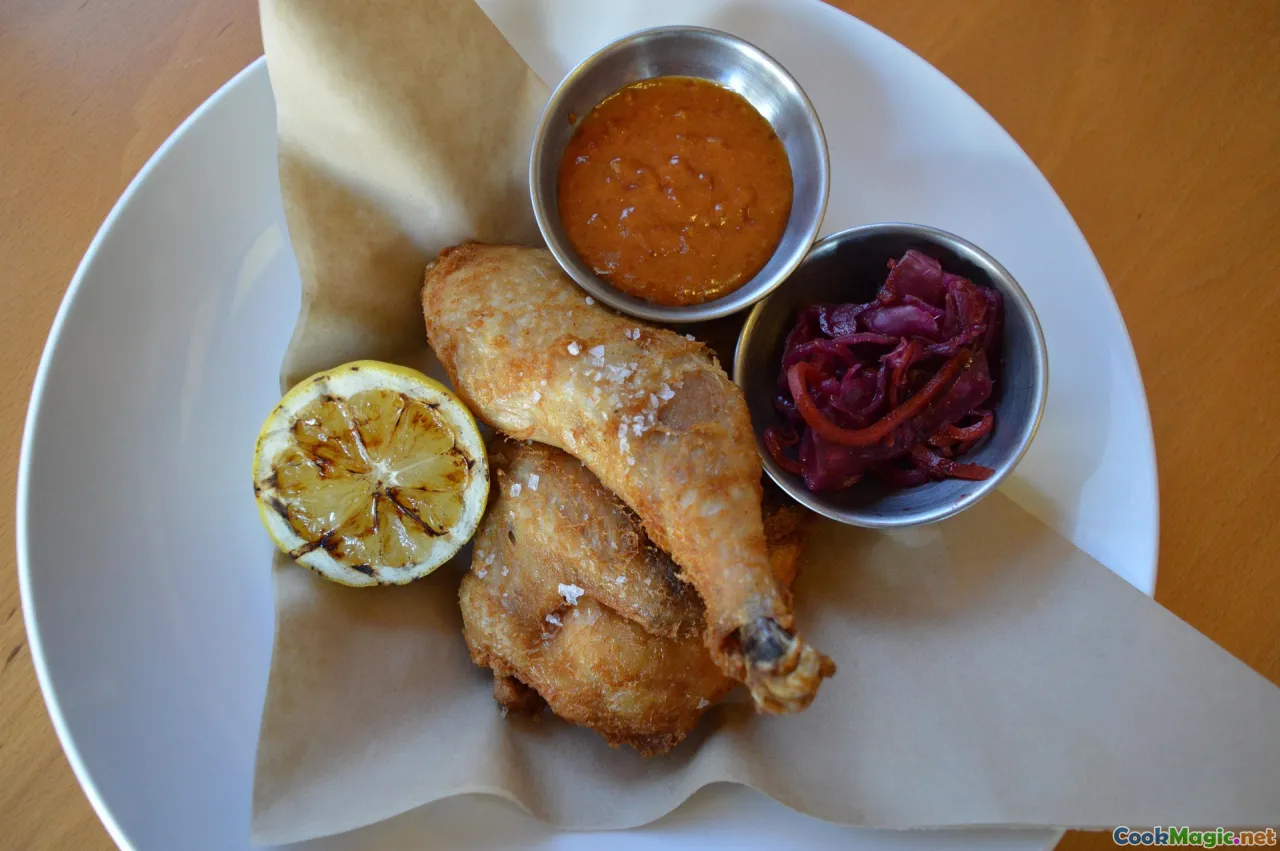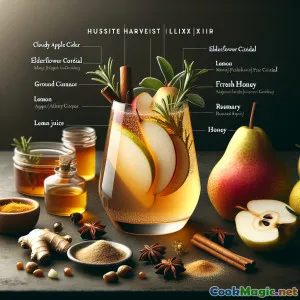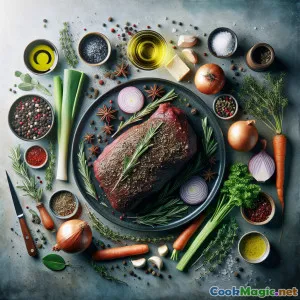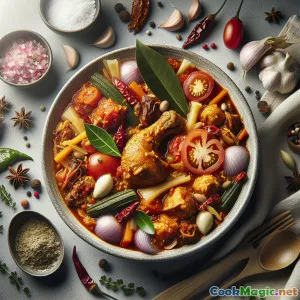
クリーミーなピーナッツハーブソースの牛タン
(Beef Tongue in Creamy Peanut-Herb Sauce)
(0 レビュー)材料
-
1 whole (approx. 1.2kg) 牛タン
(新鮮で清潔な舌が最高の風味を生み出します。)
-
85 grams ピーナッツ
(ロースト済み、無塩; バリエーションとしてカシューナッツを使用できます。)
-
30 grams フラットリーフパセリ
(ざっくり刻む)
-
15 grams 新鮮なミントの葉
(茎を除去済み)
-
10 grams タラゴン
(任意ですが、味の深みを引き出すために強く推奨します。)
-
2 cloves ニンニク
(潰した)
-
1 teaspoon イングリッシュマスタード
(弱火を加える)
-
2 tablespoons リンゴ酢
(鮮やかさを出すために)
-
1 tablespoon 蜂蜜
(酸度のバランス)
-
120 ml 全乳
(ソースを薄める)
-
1 teaspoon 塩
(お好みに調整してください)
-
0.5 teaspoon ブラックペッパー
-
1 medium 玉ねぎ
(四分割)
-
2 whole ベイリーフ
-
1 whole セロリの stalk
(香り高い煮込み用の液は任意です。)
-
1 whole ニンジン
(皮をむいた、タンの煮込み用)
-
2 liters 水
(タンの調理用)
(新鮮で清潔な舌が最高の風味を生み出します。)
(ロースト済み、無塩; バリエーションとしてカシューナッツを使用できます。)
(ざっくり刻む)
(茎を除去済み)
(任意ですが、味の深みを引き出すために強く推奨します。)
(潰した)
(弱火を加える)
(鮮やかさを出すために)
(酸度のバランス)
(ソースを薄める)
(お好みに調整してください)
(四分割)
(香り高い煮込み用の液は任意です。)
(皮をむいた、タンの煮込み用)
(タンの調理用)
栄養
- 分量: 4
- 1人分の量: 1皿(250g)
- Calories: 525 kcal
- Carbohydrates: 0 g
- Protein: 37 g
- Fat: 34 g
- Fiber: 5 g
- Sugar: 7 g
- Sodium: 680 mg
- Cholesterol: 185 mg
- Calcium: 92 mg
- Iron: 5.4 mg
作り方
-
1 - 煮込み液を用意する:
大きな鍋に玉ねぎ、ローリエの葉、塩、セロリ、にんじん(使う場合)と一緒に牛タンを入れます。完全に浸るように水を足します。弱火で煮立ててください。
-
2 - 舌を弱火で煮る。:
鍋に蓋をして弱火にし、牛タンがフォークで刺せるくらい柔らかくなるまで3時間煮込む。調理中に表面に浮かぶアクはすくい取る。
-
3 - 取り除く & 皮をむく:
舌をまな板の上に移します。少し冷ましてから厚い外皮をむきます。横方向に1 cm厚さの薄切りにします。
-
4 - ピーナッツハーブソースをブレンドする:
ブレンダーで、ピーナッツ、パセリ、ミント、タラゴン(使用する場合)、にんにく、マスタード、りんご酢、蜂蜜、牛乳、塩、こしょうを合わせる。クリーミーなソースになるまでブレンドします。必要に応じて牛乳を追加して粘度を調整してください。
-
5 - 温めて盛り付ける.:
もし望むなら、舌の薄切りを少量のブレージング液で温めます。皿に盛りつけ、ピーナッツハーブソースをたっぷりかけます。さらにハーブと刻んだピーナッツをあしらって飾ります。
大きな鍋に玉ねぎ、ローリエの葉、塩、セロリ、にんじん(使う場合)と一緒に牛タンを入れます。完全に浸るように水を足します。弱火で煮立ててください。
鍋に蓋をして弱火にし、牛タンがフォークで刺せるくらい柔らかくなるまで3時間煮込む。調理中に表面に浮かぶアクはすくい取る。
舌をまな板の上に移します。少し冷ましてから厚い外皮をむきます。横方向に1 cm厚さの薄切りにします。
ブレンダーで、ピーナッツ、パセリ、ミント、タラゴン(使用する場合)、にんにく、マスタード、りんご酢、蜂蜜、牛乳、塩、こしょうを合わせる。クリーミーなソースになるまでブレンドします。必要に応じて牛乳を追加して粘度を調整してください。
もし望むなら、舌の薄切りを少量のブレージング液で温めます。皿に盛りつけ、ピーナッツハーブソースをたっぷりかけます。さらにハーブと刻んだピーナッツをあしらって飾ります。
クリーミーなピーナッツハーブソースの牛タン :の詳細
Beef Tongue in Peanut Herb Sauce: A Modern Twist on English Fare
If you’ve ever wanted to push the boundaries of traditional English cuisine and savor the complex delights of nose-to-tail eating, look no further than Beef Tongue in Peanut Herb Sauce. This dish brings together the classic slow-cooked tenderness of beef tongue and pairs it with a creamy, vibrant sauce inspired by both British and international flavors. Its rich cultural heritage and creative modern elements make it an exceptional main course for adventurous cooks eager to exercise skill and surprise.
Background & History
Beef tongue is one of the traditional cuts treasured in English country cooking, often considered a delicacy reserved for special Sunday lunches or festive occasions. While not as commonly encountered on everyday tables in recent decades, tongue's reputation for flavor and melt-in-your-mouth tenderness remains undisputed. Historically, it would be poached simply along with aromatics and served cold, accompanied by piquant mustard or horseradish. Here, the classic cut is reimagined: the tongue is slow-simmered, deeply seasoned, and uplifted with an elegant, contemporary sauce blending roasted peanuts, fresh herbs, and the zing of vinegar.
Peanuts aren’t native to England, but found their way into the modern British kitchen through colonial and global influences. Combining them—with herbs like mint and parsley—with other local flavors is reflective of the fusion trend shaping UK dining today. Cutting through the unctuous character of offal with creamy nuttiness and bursts of green, it raises this humble classic to gourmet status.
The Art & Novelty of Offal
Eating beef tongue requires a sense of culinary adventure, but its reward is unforgettable. The meat is gently braised until supremely soft, sliced thin, and served warm—perfectly contrasted by the lush, tangy peanut herb sauce. The flexibility of the recipe (use tarragon or swap in other herbs that look best at the market) means that creative cooks can adapt based on seasonality, or to encourage wary eaters to discover delicious new favorites.
Tips & Tricks
- Tongue Preparation: Plunging the tongue into hot water as the first step makes removing the skin easy once braised. Peel very soon after braising when it's still warm for best results.
- Flavor Infusion: Aromatics like bay leaf, celery, and carrot deepen tongue's natural savory qualities. You can swap in leeks or fennel for nuance.
- Peanut Allergy? Cashews or sunflower seeds blended with herbs also yield a creamy, unique sauce for those avoiding peanuts.
- Make Ahead: Cooked tongue keeps for days in the fridge, and you can prepare the herb sauce up to a day ahead. They’re easy to assemble just before serving.
- Serving Suggestions: Pair with simply boiled new potatoes, roasted root vegetables, or a crusty British brown bread to soak up every last drop of sauce.
Cultural Significance
Beef tongue connects modern tables with a rich heritage, reminding us of a time when British cooks were ingenious in transforming humble or overlooked cuts into something splendid. Today, modern cooks are rediscovering the creativity and fullness this food offers, celebrating sustainability and whole-animal appreciation. By integrating international flavors—like peanuts and fresh tarragon—this recipe fuses contemporary tastes with time-honored values, making every meal more exciting and meaningful.
Unique Aspects & Final Thoughts
What makes this dish particularly unique is the striking interplay of earthy beefiness and silky herbal creaminess. The peanut sauce not only provides flavor, but color and body, ensuring the dish feels decadent yet unexpectedly bright and modern. It’s a conversation starter, a piece of culinary history reinvigorated for a new generation.
As a chef who loves to invite diners beyond their comfort zones, I find offal dishes like this exemplify the best of English kitchen values: thrift, creativity, and respect for the breadth of ingredients our world provides. Give it a try, and you might discover a new favorite that ... literally, and figuratively ... brings new tongue to the table.
Bon appétit!

